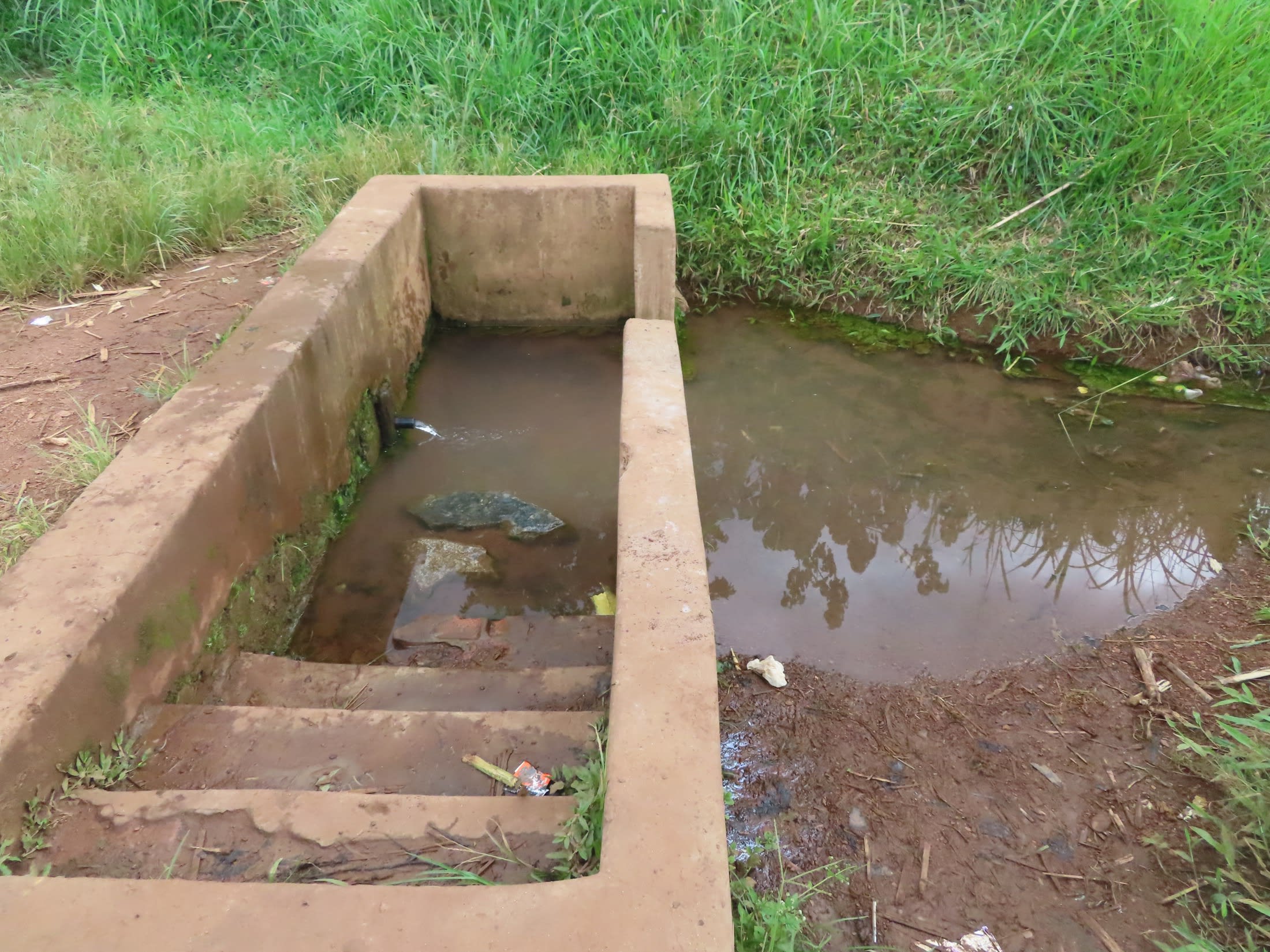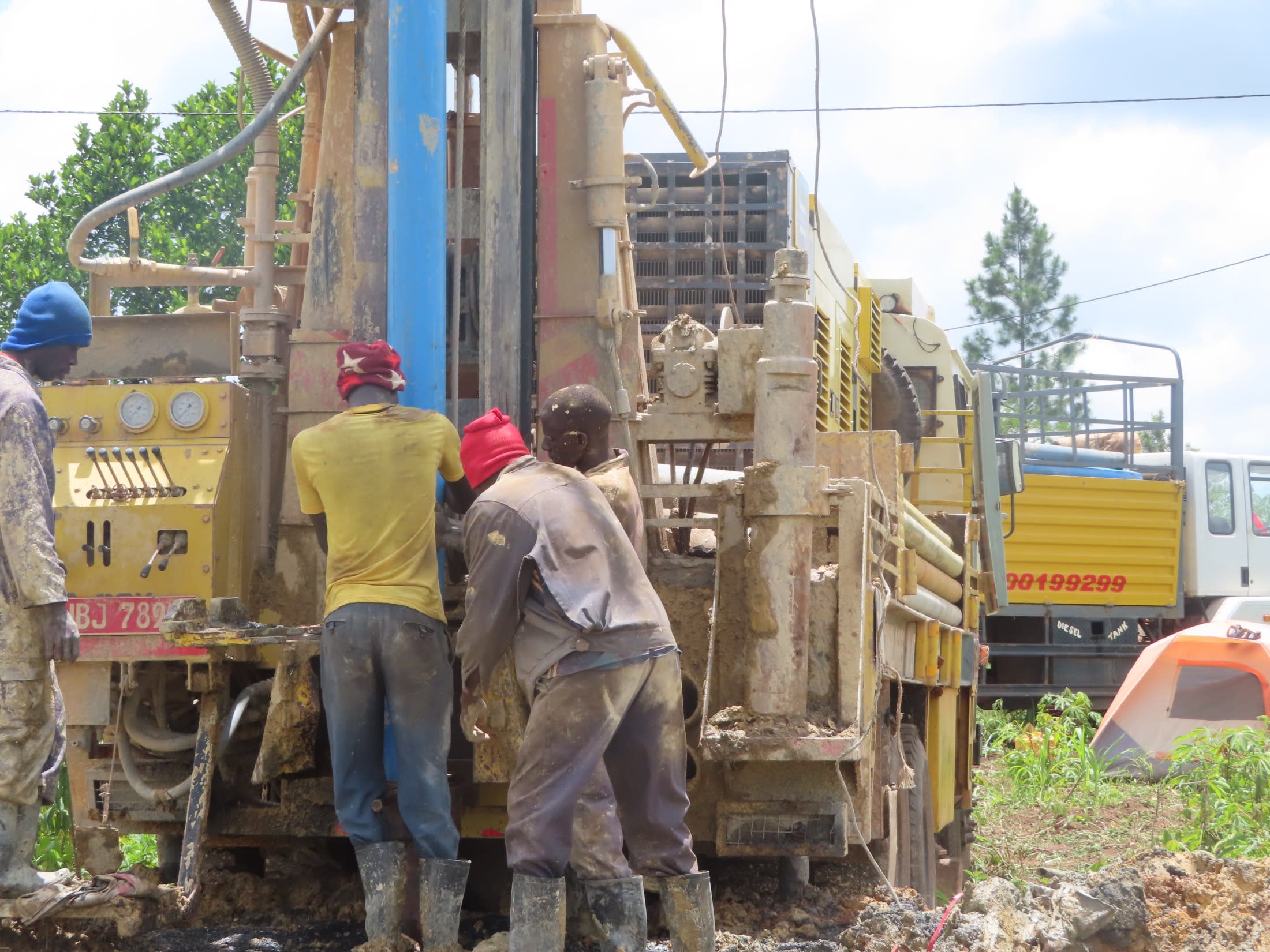Of the 850 people who live in Kyamukudumi, those who live in this area generally collect their water from faraway scoop holes twice a day.
Going to the scoop holes is dangerous. People must travel by bicycle along a busy road and navigate a steep slope that is especially difficult to traverse when it rains and the area becomes slippery. It is a tiring endeavor that most parents will not allow their children to do alone, and for those without bicycles, it is nearly impossible.
"It is quite challenging because the waterpoint is far [away]. I spend time looking for water, and this affects my daily activities like gardening and domestic work," said Harriet Aweko, a 25-year-old married woman with three children shown below standing next to a scoop hole.

Harriet's children are all under the age of eight, so they cannot collect water on their own because the trip is too challenging and labor intensive with full water jugs. Below, Harriet collects water from the scoop hole with some of her children.

The inaccessibility of the scoop hole is not the only issue facing community members that rely on it. The source is obviously contaminated, evidenced by the muddy water and wildlife living in the water, and those consuming it often suffer water-related illnesses as a result.
"The water source that I consider my primary water source is an open source that is prone to contamination," said Harriet. Harriet also shared that the cases of diarrhea, especially amongst her children, have increased due to drinking the scoop hole's water.
Twelve-year-old Patrick lives with his father since his mother died when he was three years old. "I fetch water every day, but the distance to the waterpoint is far, and the road is hilly," said Patrick, shown below using his bicycle to collect water.

Patrick continued: "The water point is not safe because it's an open source. [The] water is full of frogs and sometimes has a bad smell and changes color, especially during the rainy season. When we drink this water unboiled, it causes stomach upsets, hence causing diarrhea."

When the trip is too much for Harriet, and she wants safer drinking water for her and her family, she must buy it from a tap in a neighboring village. But it is costly and leaves her with little finances for other essential needs.

For his alternative, Patrick chooses to visit a local spring [shown in the photo above]. It is also far away, so Patrick must use a bicycle to cover the long distance, which leaves him with little time and energy for other things. And although the spring was protected at one time, it now only offers water that is not safe to consume.
Our new well will be a more accessible, safer water source within close proximity to community members' homes in Kyamukudumi. This should allow them to use their time more efficiently. Hopefully, it will also improve their health and their energy so they can get on with their daily lives without worry.
Note: Our proposed water point can only serve 300 people per day. We are working with the community to identify other water solutions that will ensure all 850 people in the community have access to safe and reliable drinking water.
Here’s what we’re going to do about it:
New Borehole
This new borehole is an exciting opportunity for this community! We work with the community to determine the best possible sites for this well.
We conducted a hydrogeological survey and the results indicated the water table is an ideal candidate for a borehole well. Due to a borehole well's unique ability to tap into a safe, year-round water column, it will be poised to serve all of the water needs for this community, even through the dry months.
Community members will help collect the needed construction materials such as sand, rocks, and water for mixing cement. They will also provide housing and meals for the work team, in addition to providing local laborers. We will complement their materials by providing an expert team of artisans and drilling professionals, tools, hardware, and the hand-pump. Once finished, water from the well will then be used by community members for drinking, handwashing, cooking, cleaning, and much more.
Training
Training’s main objectives are the use of latrines and observing proper hygiene practices since these goals are inherently connected to the provision of clean water. Open defecation, water storage in unclean containers and the absence of hand-washing are all possible contaminants of a household water supply. Each participating village must achieve Open Defecation Free status (defined by one latrine per household) prior to the pump installation for this borehole well.
This social program includes the assignment of one Community Development Officer (CDO) to each village. The CDO encourages each household to build an ideal homestead that includes: a latrine, a handwashing facility, a separate structure for animals, a rubbish pit and a drying rack for dishes.
We also implement the Community-Led Total Sanitation (CLTS) approach with each of our village partners. This aims to improve the sanitation and hygiene practices and behaviors of a village. During these sessions, village leaders naturally emerge and push the community to realize that the current practices of individual households – particularly the practice of open defecation – are not only unhealthy, but affect the entire village. CLTS facilitates a process in which community members realize the negative consequences of their current water, sanitation and hygiene behaviors and are inspired to take action. Group interactions are frequent motivators for individual households to build latrines, use them, and demand that other households do the same.
Improved Sanitation
The aim is that all households own an improved latrine. Many households do not use a latrine but use the bush. Due to open defecation, feces are spread all over the village. This leads to waterborne diseases and contamination of groundwater and surface water. Our aim is that the community is able to live a healthy life free of preventable diseases. We endeavor that at the end of our presence in the community, people will have both access to sustainable, clean water and access to sanitation. We have now organized families to form digging groups for latrine construction, and empowered them with tools to use.

 Borehole Well and Hand Pump
Borehole Well and Hand Pump
 Rehabilitation Project
Rehabilitation Project


























